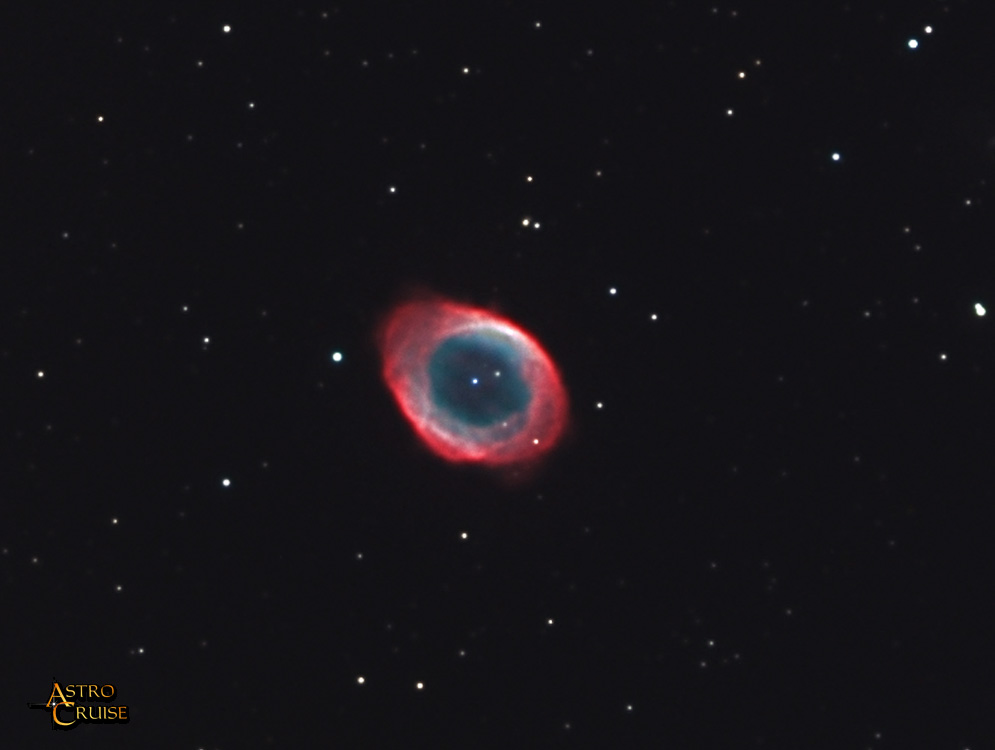
 |
Object data: M57 (NGC 6720) is the famous Ring Nebula, one of the most photographed planetary nebulae in the night sky. It is located in Lyra about midway between the stars Beta and Gamma Lyrae. Its Magnitude 8.8 visual brightness makes it easy to find even in small telescopes. Planetary nebulae are formed in the dying stages of a star when the core fusion reactions decline to the extent that the star's structure cannot be supported - gravity forces the outer part of the star to collapse inwards, causing the inner part to condense and heat up. The intense build up of pressure and radiation causes the outer shell to 'explode' and be driven away. The intense stellar wind causes the surrounding gases to ionize in bright colours. The core remnant at the centre of M57 was once a star of even greater mass than the Sun. Having ejected its outer layers into space, it is destined to die as a tiny white dwarf star, about the size of the Earth. Planetary nebulae are in fact very common in our galaxy, other noteworthy examples being the Helix Nebula and the Dumbbell Nebula, though most of them are much smaller and less significant than these examples. The Ring Nebula is about 2,000 light-years from Earth and has a diameter of about one light-year. It was discovered not by Messier but by Antoine Darquier of Toulouse in 1779. It was catalogued by Messier as Number 57 in January 1779.
Date: 23/05/01; 24/05/01
Location: Wiltshire UK
Conditions: Calm, transparency=7, seeing=7
Optics: RCOS Ritchey-Chretien 12.5" at f/9 with AP focal reducer
Mount: AP 900 GTO on Portable Pier
Camera: SBIG ST-8E / CFW-8
Guiding: Integral ST-8E guiding chip controlled via MaximCCD
Exposure: LRGB: Luminance: 5x15 minutes; RGB: 15:15:30 minutes binned 2x2Processing: Image acquisition and initial processing was done using Maxim DL, subsequent processing was done using AIP, Registar and Photoshop.
Notes: I had just completed collimation of the RC on the night of the 23rd May and only had time for four luminance images. I took one further luminance image plus the RGB sequence on the following night, 24th May. The period of darkness is very short at this time of year in the UK and in fact on the 25th May we entered a period of no astronomical darkness at all that lasts through until the 20th July. Conditions on both nights were good, with transparency rated about 70% and seeing about 70% - measured at 2.2 arc seconds. The above image was upscaled by 150% from the original ST-8E image, and then cropped to typical monitor resolution.
With this image I finally solved the RGB gradient problems as reported on the SBIG and AstroV mail lists. I am very grateful for the advice from Stan Moore, Al Kelly, Ron Wodaski, and Adrian Catterall, which was instrumental in solving this problem. The downscaled image at right is the raw RGB image (after registration with the luminance images of the night before) - very clean and with no perceptible gradients. Basically the problem was solved by meticulously taking a series of sky flats for each filter, taking new dark and bias frames, and exposing each image for longer.
|
|
|
|